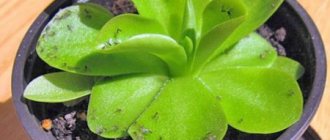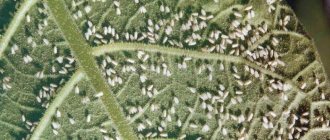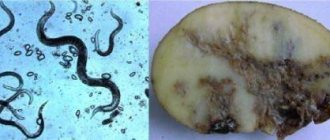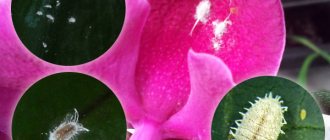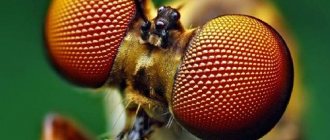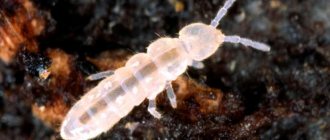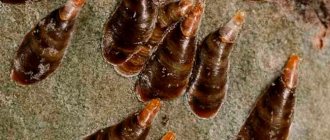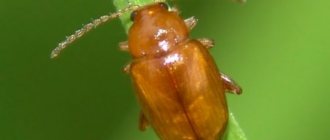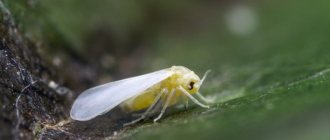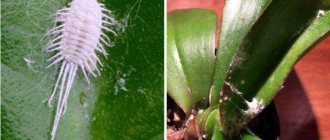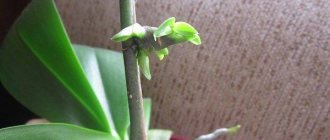Curling leaves, wilting buds, and the plant losing its attractiveness are the first signs of pests. To save the beauty on the windowsill, you need to know how to get rid of aphids on indoor flowers and prevent their appearance in the future. When fighting parasites, it is important to identify and eliminate the causes of the problem, and then destroy the pests using folk remedies or insecticides.
Aphids are a dangerous parasite that quickly adapts to any conditions and in a short time creates large colonies that destroy indoor plants. To save your home greenhouse, it is important to start pest control in a timely manner.
The article contains relevant and effective methods of combating aphids that will help save the plant and restore its attractiveness and vitality.
Description of aphids and how they appear in the house
Aphids are small insects with long legs and a pointed abdomen. The oblong body can be yellow, green, black or pink, but white pests are most often found on indoor plants.
One female aphid can lay up to 100 eggs at a time, which in a couple of weeks turn into adults that destroy flowers. Parasites use their proboscis to suck out the juice from the stems and leaves, depriving the plant of its vitality and attractiveness. In addition, they often spread viral and fungal diseases (sooty fungus). If the necessary measures are not taken in a timely manner, pests quickly adapt to any habitat and form numerous colonies that can destroy all the beauty on the windowsill.
Aphids attack different types of plants, but hyacinths, chrysanthemums, hibiscus, orchids, fuchsias and cyclamens are especially susceptible to attack by pests.
Where can pests appear in the house:
- through open windows and a balcony in the absence of mosquito nets;
- with new flowers (cut or in pots);
- from a person's clothing;
- through the soil used for transplantation;
- The carriers of the larvae can be ants that breed aphids for their own food.
To avoid the spread of aphids from a newly purchased plant to your home ones, keep it in quarantine for several days, and also carry out preventive treatment with special insecticides.
The main reason for the appearance of aphids is dried soil and high indoor temperatures.
Preventive measures
As follows from the above, preventing aphids from appearing in the house is not at all difficult. To do this, you must follow the following rules:
- All brought plants must first be quarantined, that is, kept separately from other plants, and inspected as often as possible;
- Place flowers and branches in vases as far as possible from house plants, ideally in other rooms;
- Calcinate or freeze all soil taken for flowers;
- Cover windows with mosquito nets;
- Inspect the clothes and fur of pets when entering from the street (this measure is also aimed against ticks);
- Fight black ants.
As a preventive measure, placing fragrant pelargonium (geranium) in the home flower garden can be considered. Pelargonium produces odorous phytoncides that are destructive to aphids.
Signs of pests on flowers
Aphids can cause significant damage to plants, so it is important to begin combating the parasites as early as possible. To do this, you need to know the signs of pests in your home greenhouse and periodically inspect each indoor flower for symptoms of disease.
The first manifestations of aphid infestation:
- a sticky layer and tiny punctures appear on the leaves and young shoots;
- flower buds quickly fade and fall off before they have time to bloom;
- the flower loses its attractiveness, withers and dries out;
- leaves darken and curl;
- Ants appear on the windowsill, attracted by the waste products of aphids, which are used by insects as food.
One of the signs of plant infestation by aphids is the appearance of ants. Insects feed on honeydew secreted by parasites, so they are always close to them and can even independently introduce pests to flowers
Signs of a houseplant being affected by aphids
With periodic inspections of flowers, you can notice in time that the plant is sick. External modifications will be visible on it:
- Young shoots wither and curl up.
- A syrupy trail has appeared (produced by pests).
- Blackness has spread - sooty fungus (carried by a parasite).
- Flowers have shrunk or not opened.
- The shape of the buds has changed.
- The presence of a mass accumulation of individuals on the outer side of the leaf.
- Growths have formed on the trunk.
At the initial moment, when there are still few pests, you can notice small punctures on the leaves and the insects themselves. Later they will begin to curl up. Parasites cannot bite through the bark, so they do not settle there.
If an aphid attacks young plants, its death will occur quite quickly. A large colony can stop growth and harm even a more mature flower.
Folk remedies and methods of combating aphids
You can remove aphids from indoor plants yourself using available means. Such methods are easy to use, affordable and absolutely safe for healthy flora, people and pets.
Algorithm for saving indoor plants:
- Isolation of a sick flower, which will protect the rest from infection.
- Preventive spraying of healthy flora.
- Treatment of the affected flower using the chosen method.
Folk remedies for fighting aphids are presented in the table:
| Active substance | Procedure for preparing the composition | Mode of application |
| Celandine | Grind 150 g of dried raw materials or 350 g of fresh herbs and add 1 liter of water. Leave the product in the dark for 24 hours | Spray the plant with the resulting infusion three times at intervals of a day. |
| Wood ash | Mix 50 g of soap, 0.5 l of ash and 10 l of water | Treat the affected leaves and shoots with a filtered solution until the pests are completely destroyed. |
| Garlic | Grind 30 g of garlic in a blender, add 1 liter of water and leave to brew for a day in a dark place. | Treat the flowers with the resulting product three times at intervals of 5 days. |
| Tomato tops | Grind 500 g of raw material, add 1 liter of water and boil for 30 minutes. Add 4 g of liquid soap to the cooled broth | Treat the affected plant until complete recovery. |
| Tobacco | Combine raw materials and water in a 1:2 ratio and let it brew for 2 days. | Dilute the resulting infusion with water and spray the flower. Avoid contact with the soil to avoid damage to the root system. |
| Hot pepper | Grind 50 g of pepper and add 125 ml of water. Boil the mixture for an hour and let it brew for a day | Dilute the filtered infusion in 10 liters of water, use for spraying and watering flowers |
| Orange peels | Pour 100 g of citrus peel with water and let it brew for a couple of days in a warm place | Spray plants affected by aphids |
| Needles | Pour 500 g of pine needles into 2 liters of water and leave for a week, then strain and dilute with water in a ratio of 1:7 | Treat the flower several times with a break of 4 days |
Geranium, dill, parsley, mint or marigold will help fight aphids. Parasites cannot stand the aromas of these plants, so by placing a pot with one of them on the windowsill, you can not only get rid of pests, but also avoid their appearance in the future.
Ladybugs can be used as a biological method of controlling aphids, so do not drive out an insect that has settled on an indoor flower
Types of aphids on flowers
There is no significant difference in the degree of parasitism between different species. They all feed on plant juices and lay eggs on the underside of the leaf. After hatching, the larvae immediately begin to wreck.
Females lay eggs without fertilization. Throughout the warm period of the year, females are born. The family lives on one plant or moves to neighboring ones. At the end of summer, winged individuals are born - females and males. This migratory generation of aphids is capable of moving to any plant and establishing huge colonies in a short time.
Important!
Over the course of several weeks of her life, the female lays about 150 eggs. Each time 40 pieces. The larvae develop in the egg in room conditions in 10 days. They penetrate into the leaf plate, disrupt its integrity, and draw out important substances. In a month, without emergency measures, the plant risks dying.
Different types of aphids clearly differ from each other in body color. Several pests appear on indoor flowers:
- White aphid. Migrating individuals with wings. Dicotyledonous plants are affected; legumes are the most susceptible to attack. The pest overwinters on pistachio trees.
- Green. Apple aphid that attacks pears, plums, and quinces. Overwinters near the buds under the bark.
- Black aphid. Garden aphids, covering several species. Body brown, blue, black. Affects any garden, vegetable crops, decorative flowers.
- Yellow. It affects coniferous trees and lives permanently on their branches. 10 generations are hatched per season. He breaks into the house by accident.
- Bloody. Characterized by a bright red color. Winters on elm. Several generations of wingless individuals grow there, then winged females and males appear and migrate to apple trees.
A photo of the aphid is located below.
Types of aphids
There is no particular point in figuring out which species has captured the home flower. All insects are called aphids; identical methods and methods of control are used. But many people are interested in where pests come from.
Mechanical methods of getting rid of pests
You can save indoor flowers using mechanical cleaning, but this method is effective only at the initial stage of infection. To preserve the plant, remove damaged leaves, buds and shoots and wash it daily under running water. A solution of laundry soap will help to achieve maximum effect. Processing procedure:
- Prepare a soap solution from laundry soap and water in a ratio of 1:6.
- Prepare the necessary attributes, put on rubber gloves.
- Soak a sponge in the solution and thoroughly wipe all leaves, shoots and stems. Avoid getting the product on the soil.
- Rinse the plant with clean running water.
- Repeat the treatment daily until the parasites are completely eliminated.
To mechanically remove aphids, wipe the leaves daily with a damp sponge, remove affected shoots and bathe the flowers under running water.
As an alternative to soap solution, you can use medical alcohol - dissolve 6 tbsp in 1 liter of water. spoons of the product and wipe all the leaves. This composition effectively removes pests and does not damage the leaves, since ammonia quickly evaporates from the surface.
To be sure to get rid of aphids, replace the top part of the soil, where eggs and larvae of pests may be. In this case, choose high-quality soil that has been disinfected or frozen.
What does a pest like?
Aphids are polyphagous and harm almost all plants. She especially likes crops whose juice is rich in carbohydrates and amino acids. Aphids with delicate leaves, succulent shoots, and lush buds are often found. Which domestic flowers are affected by the pest:
- Violet;
- Orchid;
- Calla;
- Cyclamen;
- Begonia;
- Chrysanthemum;
- Hydrangea;
- Primrose;
- Hibiscus.
The palm family is rarely attacked by aphids due to the rigidity of the leaves and shoots.
Chemicals for killing parasites
If folk remedies are ineffective, use chemicals. The choice of means depends on the degree of damage and the scale of the disaster. The most effective means include: “Decis”, “Iskra”, “Fitoverm”, “Aktellik”, “Confidor”, “Akarin”, “Karate”.
Spraying flowers with chemicals will help get rid of aphids. When working with insecticides, observe safety precautions and strictly follow the instructions for the product.
Procedure for using chemicals:
- Read the instructions for use of the product.
- Take the recommended safety measures - put on seals and a respirator, remove pets and children from the premises. After handling, wash your hands thoroughly with a concentrated soap solution.
- Wipe the leaves and stems with a sponge soaked in soapy water and then let dry.
- Spray the flower. Carry out the treatment on the balcony on a cloudy day at a temperature of +21…25 ℃, since at a lower temperature the effectiveness of the drug decreases.
- Perform preventive spraying of all plants in the house to prevent aphids from moving onto them.
- Re-treat the flowers several times at intervals of 5-7 days (depending on the recommendations in the instructions).
If the plant cannot be saved, discard it to avoid contaminating other flowers.
Varieties
In total, there are about 30 species of aphids that live on indoor plants. In a large group, the most common varieties are:
- Home;
- Ordinary potato;
- Greenhouse;
- Apple green;
- Peach;
- Cabbage;
- Tobacco;
- Mealy;
- Bakhchevaya;
- Thistle;
- Cherry.
Aphids from garden crops prefer to settle on indoor flowers in the winter.
According to color it happens:
- White;
- Pink;
- Green;
- Yellow.
Reference! Black aphids can infect flowers with pathogenic bacteria and viruses. Lead to rapid death.
Popular: Tips on what to do if the leaves of tomatoes begin to curl
Prevention of aphids
Proper plant care and compliance with the recommended preventive measures will help to avoid the appearance of aphids:
- periodically carry out preventive treatment of plants;
- Make sure to maintain the optimal temperature in the house, as insects settle in a stuffy, poorly ventilated room;
- keep new flowers in quarantine;
- install mosquito nets on all windows in the apartment;
- do not place bouquets of cut flowers (especially chrysanthemums and roses) near indoor plants;
- Soak the new soil for replanting in the cold for several days to destroy the larvae and eggs of pests.
To preserve indoor flowers, provide them with proper care, regularly inspect them to identify pests in a timely manner, and periodically carry out preventive treatment
Maintaining a favorable microclimate in the house, proper care of plants and compliance with preventive measures will help save indoor flowers from aphids. If you were unable to protect them from pests, start fighting when parasites are first detected, preventing the colony from growing. Mechanical treatment, folk remedies and chemicals can help in exterminating insects. The choice of control method depends on the scale of the disaster and individual preferences.
Mr. Summer Resident advises: ways to prevent damage to indoor plants by aphids
Every gardener knows that it is easier to prevent than to remove pests and treat a diseased plant.
It is recommended to carry out a number of preventive measures to prevent aphid infestation:
- Newly purchased flowers need to be quarantined for a while. Be sure to use a warm shower.
- The soil is kept cold (in the freezer) for a short time before planting. You can warm it up in the microwave or bake it in the oven.
- Carry out systematic inspection.
- Provide access to fresh air.
- Moisturize periodically. Sometimes put it under a warm shower.
- Prevent the appearance of ants. If they appear, then treat them.
- Use folk remedies.
Why are aphids dangerous for home flowers?
These insects pose a danger primarily to young plants with tender trunks and leaves. The female parasite lays eggs on the underside of the leaf. After the larvae hatch, they immediately begin sucking the sap from the plant. Deprived of nutrition and moisture, it sheds its buds, withers and dries up within a month.
Honeydew is also dangerous for flowers - the same “milk” secreted by aphids and so loved by ants. It promotes the appearance of sooty fungus, which eventually leads to the death of the plant.
What plants does it affect?
Aphids cause more damage to crops.
At home, you can find aphids on the following plants:
- violet;
- begonia;
- primrose;
- orchid;
- cyclamen;
- spathiphyllum;
- roses;
- chrysanthemums.
In rare cases, aphids have spread on palm trees or dracaenas, since their dense foliage is difficult to pierce with sap tubes. Also, young plants are more susceptible than older ones.
Description, what it looks like and what harm it causes?
It is difficult to detect aphids when they have just begun to settle in a plant due to the small size of the insect. The tiny body has a round or drop-shaped shape. Depending on the variety, the color of the integument can vary from pale, almost transparent, to black. Most often, white aphids are found on house flowers.
The insect is extremely prolific. The ability for parthenogenesis (virgin reproduction) and rapid maturation of larvae allows the number of pests to increase hundreds of times in just a short time. A colony of aphids on a plant looks like many small specks. Only upon careful examination can you see that they are moving. Most of them are wingless individuals. The winged generation is born from fertilized eggs. Their task is to expand their habitat.
Appearance
The pest feeds on plant sap, piercing leaves or young shoots with its proboscis. The flower begins to wither and may die. Honeydew, which is excreted by insects, coats the leaves with a sticky coating. Sooty fungus quickly develops on it.
Chemical preparations for aphids
Chemical treatment against aphids is quite dangerous, but the most effective method. Chemicals are used in case of severe infection, as well as if pest colonies have spread to a large number of plants.
Fitoverm
"Fitoverm" is an insecticide that is used to treat garden plants, garden trees and indoor flowers. You can notice the effect of the drug 2-3 days after treatment.
A 3-5 ml bottle or ampoule is suitable for indoor plants.
Method of dilution and use of the drug:
- For 1 liter of clean water, use 2-3 g of the drug.
- Heat the water.
- Pour water into different containers - approximately 80% and 20%.
- Dissolve the drug in a smaller volume of liquid, and then carefully combine the 2 parts.
The solution must be used within 2-3 hours after preparation. The liquid must be poured into a spray bottle and sprayed.
Aktara
"Aktara" is an insecticide that affects the gastrointestinal tract of pests. The chemical is packaged in sachets. The weight of one is 4 g. A solution is prepared for use, and then sprayed.
The peculiarity of Aktara’s action is its fast and effective work - after 1 hour the first results can be noted.
The drug is effective for up to 60 days, and does not affect the plant (does not have a cumulative effect) when used multiple times.
Aktellik
The drug "Actellik" is another fast-acting insecticide, which is sold in 2 ml ampoules.
The manufacturer recommends using the product in cases where other control methods do not help. The product is dangerous and quite toxic (belongs to class 2).
Despite the toxicity of the substances, Actellik can be used to treat tools and premises. It must be remembered that the product is dangerous for all living creatures in water and land.
Spark
“Iskra” is a drug that helps with plant infestation by various pests. The drug helps against 100 types of insects. "Iskra" is available in 4 forms, which help with different degrees of damage.
The drug is harmless to plants and humans. At the same time, Iskra does not destroy the pest 100%.
Tanrek
"Tanrek" is an effective insecticidal preparation used for spraying plants. The effect of the drug occurs after 3-5 days. The drug affects the central nervous system of the insect, causing paralysis and death.
Pour 2-5 ml of solution into 1-2 liters of water and mix thoroughly. Spray the plants with liquid. Store the solution for no more than 2 hours.
